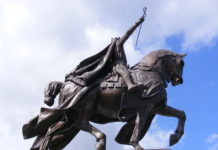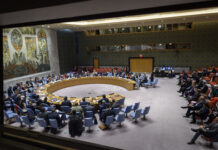Photo credit: DiasporaEngager (www.DiasporaEngager.com).
For months, Indian Prime Minister Narendra Modi swaggered on campaign trail with a popular chant: “ab ki baar, 400 paar” (this time, 400 plus). His bluster, however, couldn’t survive the election outcome on June 4, which left him and his Bhartiya Janta Party (BJP) draped in a pall of gloom. As of the last count, the BJP fell short of Modi’s goal of 400 seats in the lower house of the Indian parliament, garnering only 240 seats out of 543. When the dawn of June 4 broke, his party had 63 fewer seats than it claimed in the 2019 election.
In the last election, the BJP captured a governing majority to elect its prime minister unaided by any other parliamentary grouping. This year it couldn’t muster even 303 seats despite an assortment of allies in the National Democratic Alliance (NDA) that it leads. Instead, the NDA, together with the BJP, grossed 293 seats in all, which still does not match what the BJP achieved five years ago. With this lackluster performance, the BJP had to scramble for 32 more votes to have any real shot at electing Modi for a third term. For now, it wasn’t that hard to rustle up these 32 votes, as BJP’s allies see more concessions coming their way by sticking with it. The real test, however, lies in how long this alliance remains intact, and at what cost.
On the other hand, the Indian National Development Inclusive Alliance (INDIA), Modi’s rival group led by Rahul Gandhi and his Indian National Congress party, has won 232 seats, just 8 seats short of the BJP’s total. With this score INDIA is only 40 votes away from forming a government of its own. The Indian constitution requires 272 votes in the lower house of parliament to elect a prime minister to form a government. Modi’s alliance has several left-leaning parties in its fold, whose natural habitat is INDIA. They can desert Modi at an opportune time and decamp to the opposition. Two of Modi’s allies, with enough votes to cause the government to fall, are known for switching sides. Ideologically they are far apart from Modi’s Hindu-first nationalism. One of the pair, Natish Kumar, a nine-time chief minister, is a self-professed socialist. All this makes their alliance with the BJP wobbly.
This instability will strip Modi of his characteristic authoritarianism. From now on, he will have to look over his shoulder all the time to make sure that every ally stands beside him. Seeking their consent and keeping them appeased will be a challenge for someone like Modi who has been used to going it alone. More importantly, INDIA will hang over him like the sword of Damocles. As time goes by, poaching 40 members of Modi’s alliance will get easier for INDIA, which must decide whether it is better to topple a lame-duck prime minister and take over the government or wait for voters in the next election to send Modi packing.
Gandhi had already won plaudits for a well-run campaign. He stitched together a diverse alliance and managed above all to keep it together. The strong showing of INDIA in general, and that of the Indian National Congress in particular, owes something to Gandhi’s 136-day march on foot across the country that reestablished his lost connection to the voters. While on the march, his message was blunt, which resonated with the electorate: We’ve had enough of 10 years of Modi’s crony capitalism, which gave us inflation, unemployment, and ever-deepening inequalities. He talked about the big businesses that got bigger and bigger by hobnobbing with Modi.
He also named names: (Gautam) Adani and (Mukesh) Ambani, the two richest businessmen of India, who often make it to the Forbes’ list of the world’s top 10 billionaires. At $400 billion, the value of their companies exceeds the entire GDP of neighboring Pakistan. Both are found in the close orbit of Modi’s nouveau-riche friends. “The load of money Mr. Modi has lavished on Adani and Ambani, we shall redistribute it to India’s poor,” Gandhi promised in a videoed message. Modi prides himself on being business-friendly, pro-growth, and a magnet for foreign direct investment (FDI), but how many of those businesses he befriended and how much of the growth he championed and FDI he attracted actually contributed in taxes, job growth, or public goods?
Gandhi’s messaging was in line with the longstanding identity of his Indian National Congress party, and that of his great-grandfather Jawaharlal Nehru, the founding prime minister of India. The Congress was a “distributional coalition” that wanted all segments of society to grow together. It saw no contradiction between growth and distribution. The supplying of a poor household’s needs with jobs and public works, in its reckoning, spurs growth, and growth ought to be equitably distributed. The former needs the invisible hand of the market, the latter the visible hand of the state.
Modi and his BJP, on the contrary, were a “coalition of accumulation” that wanted capital to grow, and capital growth, in their estimation, was to automatically distribute itself. The coalition of accumulation was a long way from the vision of India’s founding leaders, Nehru and Mahatma Gandhi, who respectively dreamed of setting the country on course to “self-sufficiency” (Gandhi) and “social democracy” (Nehru). India’s constitution still calls the country the Socialist Republic of India, which Modi sought to change with 400-plus votes.
India did embrace the message of Gandhi. For working and middle-class India, Gandhi’s message was their daily lived experience: inflation, unemployment, jobless growth, and a growing gap between have-nots and have-a-lots. Northern India, which bore the brunt of Modi’s neoliberal free-market policies, humbled him at the ballot box. Uttar Pradesh (UP)—the country’s largest state with 80 seats in parliament—is the best gauge of the national mood in any election. As goes Uttar Pradesh, so goes India. UP voted with its feet, handing 43 of its 80 seats to the opposition, while Modi’s share dropped to half of what it was in 2019.
Modi’s personal humiliation began in his own constituency in the UP city of Varanasi. In 2019, Varanasians elected him with a gigantic lead of 500,000 votes. This year the number fell to less than one-third: 150,000. India’s largest anti-capital farmers’ coalition was also located in the north, a coalition that waged a year-long protest against Modi’s pro-agribusiness policies. In addition, Modi and the BJP have grown a vast base of hundreds of millions of Hindu nationalists, who just want government and its leaders to echo their religious orthodoxies and illiberal ideologies. Above all, they spur accumulation by opposing its distribution.
One key lesson ignored by much of commentary in the United States is the Indian election integrity that is the very basis of democracy. Election integrity alone doesn’t build democracy, but no democracy can survive without it either. Since 2020, the United States has been in the grip of a feverish “stop-the-steal” movement that falsely claims that the 2020 election was stolen. Now that the country is ready to go into another election this year, the presumptive Republican nominee for president, Donald Trump is darkly warning of “bloodshed” if he loses this election. This is the kind of backsliding that can push an almost 260-year-old democracy into mortal danger.
India, even under a right-wing authoritarian leader who is far from being a defender of democracy, conducted an election the outcome of which has been uniformly accepted by the opposition as well as the ruling alliance. Free and fair elections and the peaceful transfer of power have been the norm in India. With one of the lowest literacy rates even in south Asia, India accomplishes such election integrity through a robust election commission whose independence and impartiality have been beyond reproach. When the first BJP prime minister lost the vote in 2004, he was quick to concede the election, which paved the way for the rival Indian National Congress to form a government. Perhaps come November, the United States can learn from India to accept the outcome of elections.
Source of original article: Foreign Policy In Focus (fpif.org).
The content of this article does not necessarily reflect the views or opinion of Global Diaspora News (www.GlobalDiasporaNews.com).
To submit your press release: (https://www.GlobalDiasporaNews.com/pr).
To advertise on Global Diaspora News: (www.GlobalDiasporaNews.com/ads).
Sign up to Global Diaspora News newsletter (https://www.GlobalDiasporaNews.com/newsletter/) to start receiving updates and opportunities directly in your email inbox for free.
































